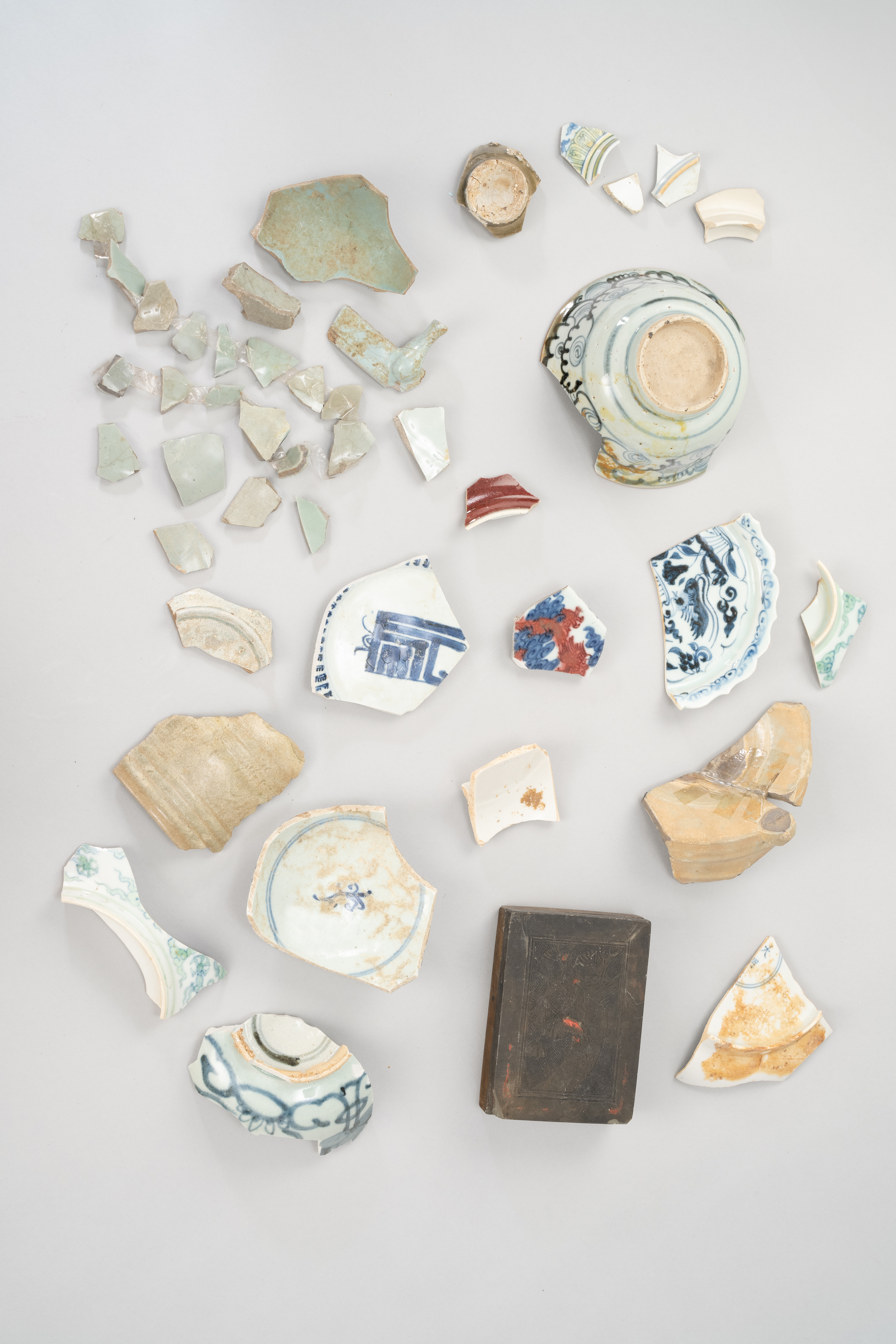comprising a total of 115 glass fragments and seven miniature glass bottles or ointment jars, contained in a variety of small cardboard, lacquer or ivory boxes and paper envelopes. The glass fragments include four lustre fragments from flask, beakers or small bowls, one of which has part of an inscription, made in naturally-coloured glass. One elaborate fragment is decorated on both sides in muted greens and yellows, and there are four fragments with streaky reddish-brown lustre on green glass. There are 46 fragments of mostly purple glass vessels decorated with opaque white or sometimes opaque light turquoise marvered trailing either left in spirals or combed to form festoons and feather patterns, including bases from 12 square-sectioned flasks with tapering bodies, while other pieces are further decorated with gilded scrolling. Among the moulded vessels there are three fragments with impressed tonged decoration and part of the body from a mould-blown flask with scrolling tendrils. There are 13 fragments of Mamluk gilt and enamelled glass including rare examples in dark blue and in opaque turquoise glass and a colourless fragment with part of a turbaned figure, while some pieces are decorated on both sides of the vessel wall. Other interesting pieces include a gold-glass tessera, part of a moulded glass tile with small raised squares, two prunted fragments where the applied prunts have turquoise tips, half a body from a flattened small bottle with cut decoration, an opaque streaky red pushed-in base from an Egyptian bowl, part of an Islamic glass weight, a Roman opaque white and emerald-green cased fragment, an emerald-green heart-shaped inlay, a rim fragment from a mosaic glass bowl, a broken polychrome mosaic glass rod, and a late Roman painted bowl fragment. Together with excavation drawings by Ralph-Pinder Wilson (115)
comprising a total of 115 glass fragments and seven miniature glass bottles or ointment jars, contained in a variety of small cardboard, lacquer or ivory boxes and paper envelopes. The glass fragments include four lustre fragments from flask, beakers or small bowls, one of which has part of an inscription, made in naturally-coloured glass. One elaborate fragment is decorated on both sides in muted greens and yellows, and there are four fragments with streaky reddish-brown lustre on green glass. There are 46 fragments of mostly purple glass vessels decorated with opaque white or sometimes opaque light turquoise marvered trailing either left in spirals or combed to form festoons and feather patterns, including bases from 12 square-sectioned flasks with tapering bodies, while other pieces are further decorated with gilded scrolling. Among the moulded vessels there are three fragments with impressed tonged decoration and part of the body from a mould-blown flask with scrolling tendrils. There are 13 fragments of Mamluk gilt and enamelled glass including rare examples in dark blue and in opaque turquoise glass and a colourless fragment with part of a turbaned figure, while some pieces are decorated on both sides of the vessel wall. Other interesting pieces include a gold-glass tessera, part of a moulded glass tile with small raised squares, two prunted fragments where the applied prunts have turquoise tips, half a body from a flattened small bottle with cut decoration, an opaque streaky red pushed-in base from an Egyptian bowl, part of an Islamic glass weight, a Roman opaque white and emerald-green cased fragment, an emerald-green heart-shaped inlay, a rim fragment from a mosaic glass bowl, a broken polychrome mosaic glass rod, and a late Roman painted bowl fragment. Together with excavation drawings by Ralph-Pinder Wilson (115)
.jpg)













Testen Sie LotSearch und seine Premium-Features 7 Tage - ohne Kosten!
Lassen Sie sich automatisch über neue Objekte in kommenden Auktionen benachrichtigen.
Suchauftrag anlegen